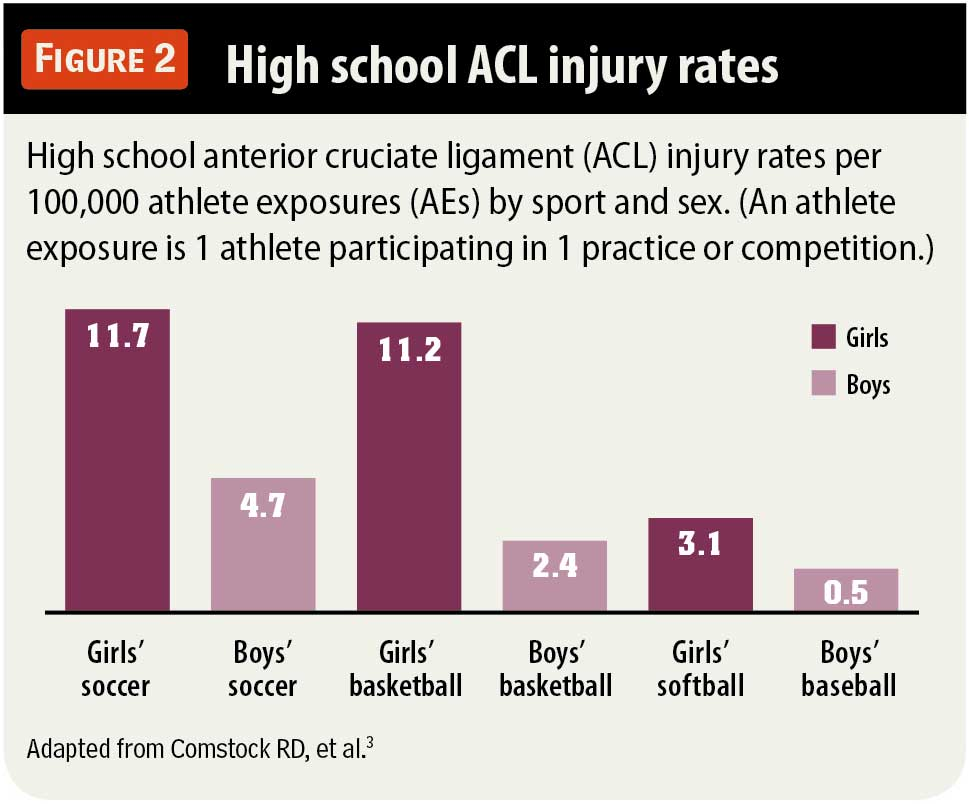ACL injury rates in women athletes are notably higher than their male counterparts, drawing attention to a pressing issue in sports science. Recent research highlights that the causes of this disparity extend beyond mere biological differences, suggesting that social factors play a critical role in these alarming statistics. Studies indicate women athletes face unique challenges, including smaller team sizes and lower investment in training resources, which can increase their risk of anterior cruciate ligament injuries. This concern has spurred a wave of inquiry into gender disparities in sports, prompting calls for more effective injury prevention strategies tailored to female athletes. By understanding the nuances behind these injury rates, we can develop targeted approaches to enhance safety and participation for women in sports.
The conversation surrounding the heightened rates of ACL injuries in female athletes unveils a complex interplay of societal and biological influences that contribute to this phenomenon. Factors such as unequal resources in training and team dynamics complicate the straightforward understanding of why women are more prone to such injuries. This topic, often framed within the context of gender disparities in athletic participation, underscores the need for innovative strategies to mitigate injury risks. As researchers delve deeper into the social underpinnings of these trends, the imperative for accurate data and robust injury prevention mechanisms becomes increasingly clear. Ultimately, fostering a supportive environment for women athletes is key to addressing the significant challenges they face in maintaining their athletic health.
Understanding ACL Injury Rates in Women Athletes
ACL injuries are a critical concern in the realm of women’s athletics, significantly affecting performance and overall health. Recent studies illuminate that the rate of ACL injuries in female athletes is 1.7 times greater than in their male counterparts. This heightened risk is not solely attributed to biological differences; rather, it stems from a complex interplay of social factors, including team size, training opportunities, and resource allocation. As women athletes often compete on smaller teams and may experience less intensive training regimes, their exposure to injury during critical game time increases.
The exploration of ACL injury rates in women athletes highlights the urgent need for improved methodologies in sports science research. Historically, metrics such as athlete-exposures have simplified injury statistics without considering individual player circumstances and conditions. This inadequacy can lead to misinformed conclusions regarding the true nature of injury risks, overshadowing the crucial social factors that may compound these rates. A more nuanced understanding is required to develop targeted injury prevention strategies that address these inequities.
The Role of Social Factors in ACL Injuries
While biological differences have long been the focal point in discussions regarding ACL injuries in women athletes, sociocultural factors play an equally significant role that needs to be addressed. The structure of women’s teams, often smaller in size compared to men’s, can lead to increased exposure to injuries since athletes have reduced time spent in optimal training. As highlighted in recent research, the fewer the athletes on a team, the higher the likelihood that an individual player may face a greater risk of injury due to inadequate practice time and competition experience.
Furthermore, the investment disparity in women’s sports manifests in various forms, from less access to quality training facilities to fewer resources for injury prevention strategies. This underfunding impacts not only the performance level of women athletes but also their longevity in competitive sports. Acknowledging these social factors is essential for creating effective injury prevention strategies, advocating for equitable resource allocation, and ultimately protecting women’s athletic health.
Gender Disparities in Sports Science Research
Gender disparities in sports science have significant implications for understanding ACL injuries among women athletes. Historically, much of the research surrounding athletic injuries has focused predominantly on male athletes, leading to a skewed perspective on injury dynamics. The recent push for more gender-inclusive research aims to illuminate the unique challenges faced by women in athletics, including specific risk factors related to ACL injuries. This shift is crucial for developing a comprehensive understanding of how sex and gender interact within the realm of sports injury.
By critically examining the methodologies used in injury research, scholars highlight the biases embedded within traditional metrics, such as athlete-exposures. These metrics have often failed to account for the nuances of gender-specific experiences, thereby misrepresenting the true risks involved. As the sports science community increasingly prioritizes gender equity, it opens the door for more accurate and representative data that can inform effective injury prevention strategies tailored specifically for women athletes.
Injury Prevention Strategies for Women Athletes
Effective injury prevention strategies for women athletes are paramount for reducing ACL injury rates and ensuring long-term athletic success. Current research emphasizes the importance of comprehensive training programs that account for the unique physiological and biomechanical differences in women. Tailored strength and conditioning programs, focused on stability and flexibility, can empower female athletes to better withstand the demands of their sport and mitigate their risk of injury.
In addition to physical training, educating athletes about their own bodies and the specific risks they may face is vital. Providing access to resources such as physical therapy and experienced coaching can enhance athletes’ understanding of self-care and recovery strategies. Ultimately, integrative injury prevention strategies that encompass education, individualized training, and adequate recovery protocols will significantly contribute to decreasing ACL injury rates in women athletes.
The Importance of Research in ACL Injury Understanding
Ongoing research into ACL injuries is essential for understanding and addressing the concerns surrounding women athletes. Innovations in sports science research are shedding light on the multifaceted nature of injuries, moving beyond simplistic biological explanations. Investigative work at institutions like Harvard’s GenderSci Lab is pioneering efforts to dissect the social, organizational, and individual factors that contribute to high injury rates in female athletes. This updated perspective is a significant stepping stone toward effective injury prevention and improved health outcomes.
Research serves to inform various stakeholders including coaches, athletic directors, and policymakers about the importance of acknowledging and addressing gender disparities in athlete health. As the field progresses, it is crucial that studies maintain a focus on not only injury rates but also the broader context in which these athletes operate, emphasizing the need for equitable resources and support systems. Enhanced understanding through research paves the way for future innovations in training protocols, ultimately leading to safer sporting experiences.
Actionable Insights for Gender Equity in Sports
The dialogue surrounding ACL injuries in women athletes presents actionable insights that can drive gender equity in sports. Advocating for fair funding and equitable resources for women’s sports can create an environment where female athletes can thrive without disproportionate injury risks. Awareness of the biases within traditional metrics can lead to re-evaluations and improvements in data collection methods, ensuring that women’s experiences in sports are accurately represented and addressed.
Implementing policy changes that prioritize women athletes’ health and safety can further bridge the gap currently existing in sports science research. This includes investment in comprehensive training, recovery programs, and ongoing education about injury risks tailored specifically for female athletes. These proactive steps are crucial for building a sports culture that not only recognizes the unique challenges women face but actively works towards mitigating these challenges through informed and thoughtful strategies.
Evaluating Current Methodologies in ACL Risk Assessment
The critique of existing methodologies used in ACL risk assessment represents a turning point in sports science research. The reliance on overly broad metrics, like athlete-exposures, can obscure the true nature of injury risks faced by women athletes. By reevaluating how exposure is calculated and considering individual circumstances as opposed to a one-size-fits-all approach, researchers can obtain a more accurate picture of the risks involved. This refinement is essential for developing targeted interventions that reflect the realities of women’s athletic experiences.
New strategies in risk assessment must incorporate a comprehensive understanding of training regimes, game days, and recovery processes. By applying these criteria, researchers can ensure that the data gathered is relevant and practical for developing effective injury prevention measures. A focus on individualized assessments will also allow for greater personalization of training programs, tailored to each athlete’s needs and helping to mitigate the risk of ACL injuries in a more effective manner.
Future Directions in ACL Injury Research
As the conversation around ACL injuries evolves, future research must continuously adapt to incorporate emerging findings and technologies. Emphasizing an interdisciplinary approach that combines sports science with insights from sociology and gender studies will provide a well-rounded understanding of the complexities associated with ACL injuries in women athletes. Research initiatives should aim to explore broader implications, including the impact of societal attitudes toward women in sports and how these attitudes influence participation and injury rates.
Additionally, as women athletes achieve more visibility and recognition in the sporting world, the demand for continued research and advocacy grows. Focusing on longitudinal studies that track injury incidences over time will allow researchers to identify trends and response effectiveness. Future directions should also consider leveraging technology for injury prediction models, enabling proactive measures that can significantly enhance athlete wellness and reduce ACL injuries.
Building a Supportive Infrastructure for Women Athletes
Creating a supportive infrastructure for women athletes is vital in reducing ACL injury incidences and promoting overall athletic well-being. This infrastructure should include not only adequate training facilities but also access to quality coaching, sports medicine professionals, and mental health resources. Ensuring that women athletes are supported in every aspect of their sport, particularly through injury prevention strategies, is essential for fostering a healthy competitive environment.
Additionally, establishing mentorship programs that connect female athletes with experienced professionals can empower the next generation of sportswomen. These programs can cultivate a deeper understanding of sports science, injury risks, and self-advocacy for health and safety. Ultimately, a collaborative approach among stakeholders in women’s athletics will solidify efforts to enhance infrastructure, reduce ACL injury rates, and promote long-term success in women’s sports.
Frequently Asked Questions
What are the reasons for higher ACL injury rates in women athletes?
ACL injury rates in women athletes are often attributed to a combination of biological factors, such as hormonal cycles and anatomical differences, as well as social and structural factors. Recent sports science research indicates that women face higher ACL injury rates due to unequal resources, smaller team sizes, and less training time compared to male athletes, which may contribute to a greater risk during active competition.
How do athlete-exposure metrics impact ACL injury rates in women athletes?
Athlete-exposure metrics commonly used in sports science can distort the understanding of ACL injury rates in women athletes. These metrics often measure exposure at a team level rather than an individual level, failing to account for the different training and competition conditions that women face. This can lead to an inflated perception of ACL injury risk among female athletes when compared to their male counterparts.
What role do social factors play in the ACL injury rates of women athletes?
Social factors significantly contribute to ACL injury rates in women athletes. Underfunding and fewer resources for women’s sports lead to lower participation levels and less optimal training conditions. These disparities can exacerbate the risks associated with ACL injuries, making it crucial to consider these elements alongside biological factors when addressing injury prevention strategies.
How can injury prevention strategies be improved for women athletes regarding ACL injuries?
Improving injury prevention strategies for women athletes involves addressing both the structural inequities in sports and enhancing training conditions. Recommendations include ensuring equal access to coaching, physical therapy, and resources. Additionally, refining the metrics used to calculate ACL injury rates to include individual athlete-exposure assessments can lead to better-targeted interventions and risk assessments.
What findings did the recent study on ACL injuries in women athletes reveal?
The recent study published in the British Journal of Sports Medicine revealed that ACL injury rates among women athletes are 1.7 times higher than those of men. The study challenges traditional explanations based solely on biological differences, emphasizing the need to consider societal factors and methodological biases in injury research.
What can be done to address gender disparities in ACL injury rates in sports?
To address gender disparities in ACL injury rates in sports, a multifaceted approach is required. This includes advocating for equitable funding and resources for women’s sports, refining research metrics to account for individual exposure, and studying the impact of social inequities on injury risk. Movement towards a more equitable sports environment will help reduce ACL injuries in women athletes.
| Exposure Measures | Men | Women |
|---|---|---|
| Roster size-based AEs | 28 | 25 |
| Participant-based AEs | 19 | 17 |
| Player-hours | 6 | 6 |
Summary
ACL injury rates in women athletes are significantly higher than in their male counterparts, influenced by complex social and structural factors rather than purely biological differences. Recent research has highlighted the shortcomings of traditional metrics used to gauge athlete exposure to injury, revealing that women’s teams often train less and are underfunded compared to men’s teams, which ultimately contributes to a higher risk of ACL injuries. By refining how we calculate and analyze ACL injury rates, incorporating individual athlete-level data and considering inherent biases in current metrics, we can better address these critical disparities in women’s sports.



